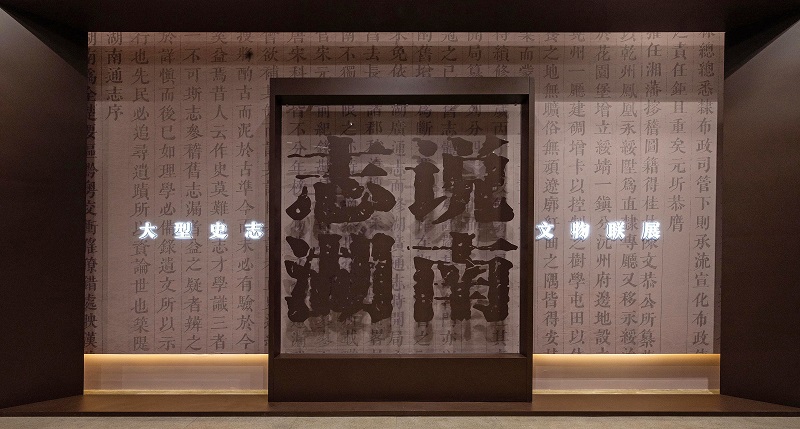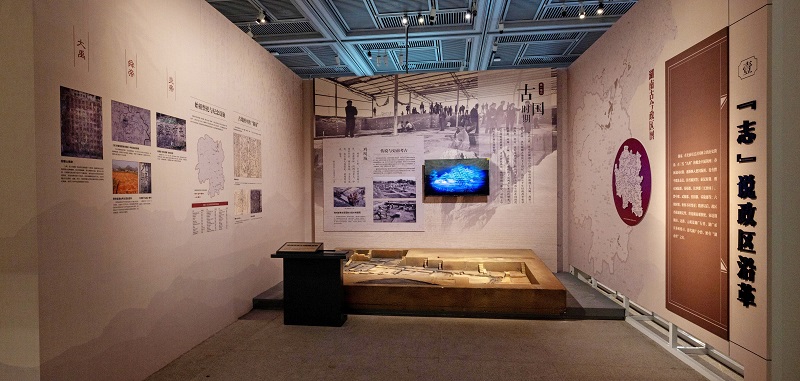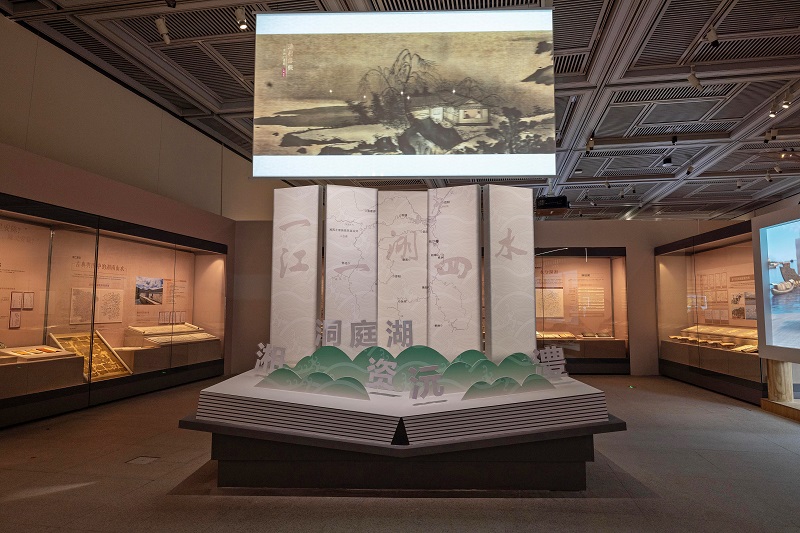"Chronicles of Hunan" - A Grand Joint Exhibition of Local Chronicles and Cultural Relics Kicked off in Hunan Museum
On November 19th, the opening ceremony of the "Chronicles of Hunan - A Grand Joint Exhibition of Local Chronicles and Cultural Relics" was held in the art hall on the first floor of the Hunan Museum. More than 100 guests attended the event, who come from the Hunan Provincial Local Chronicles Compilation Institute, the Hunan Provincial Department of Culture and Tourism, the Cultural Relics of Hunan, the Hunan Museum, the Hunan Local Chronicles Museum, the Hunan Library, and the Hunan Provincial Cultural Center.
Taking "Chronicles of Hunan" as the theme, this exhibition delves into the wisdom in the chronicles of successive dynasties in Hunan. It takes historical records, local customs, and cultural heritage as clues, vividly reproducing the customs and historical changes of Hunan, fully demonstrating the diverse charm of this land.
This exhibition showcases a total of nearly 300 pieces (sets) of exhibits. These exhibits cover a wide range of categories such as paintings, calligraphy, bronze wares, ceramics, jades, embroideries and so on. Through the integration of local chronicles with cultural relics, intangible cultural heritage, and technology, this exhibition presents the past and the present in a unique way and from different perspectives. It vividly narrates the history and stories of Hunan to the audience, enabling more people to understand and engage with the culture of Hunan and to experience the wisdom and emotions of the people on this land.
Introduction
"Chronicles" Linking the Past and Present
Local chronicles refer to documentary literature that comprehensively and systematically records the history and current situation of the natural, political, economic, cultural, and social aspects of a specific administrative region. They are important carriers for carrying on Chinese civilization and play the roles of "preserving history, educating people, and providing references for governance". Compiling local chronicles is a cultural activity unique to the Chinese nation. During the more than one thousand years from the Eastern Han Dynasty to the Northern Song Dynasty, local chronicles were circulated under various names such as Di Ji (local records), Di Zhi (local chronicles), Tu Jing(illustrated classics), and Tu Zhi(illustrated chronicles). By the Southern Song Dynasty, they were mostly called Zhi, with the style basically taking shape and the content tending to be complete. Since the founding of the People's Republic of China, due to the high attention paid by the Party and the government, the cause of local chronicles has achieved significant development.
"Chronicles" on the Evolution of Administrative Regions
In prehistoric times, Hunan had a historical stage with numerous ancient states. In the concept of "Nine Regions" during the Xia, Shang, and Zhou Dynasties, Hunan belonged to Jingzhou (which was a large region with specific geographical and cultural characteristics). During the Spring and Autumn Period and the Warring States Period, it was gradually incorporated into the territory of the Chu State, with Qianzhong Prefecture, counties, and vassal states of enfeoffed lords established there. In the Qin and Han Dynasties, there were Changsha Prefecture (Changsha Kingdom), Qianzhong Prefecture, Dongting Prefecture, Cangwu Prefecture, Wuling Prefecture, Guiyang Prefecture, and Lingling Prefecture, etc. During the Six Dynasties Period, the political power changed from time to time. After the Sui and Tang Dynasties, the names of administrative regions gradually took shape. In the Tang Dynasty, the Hunan Surveillance Commissioner was set up. In the Song Dynasty, there were “Jinghu Nanlu”(equivalent to an administrative region in the south of Jinghu area in the Song Dynasty)and“Jinghu Beilu”(equivalent to an administrative region in the north of Jinghu area in the Song Dynasty). In the Yuan and Ming Dynasties, the Huguang Province and the Huguang Provincial Administration Commissioner's Office were established. In the Qing Dynasty, with the separation of Huguang, the name of "Hunan Province" came into being.
"Chronicles" on Astronomy and Geography
Hunan is located in the middle reaches of the Yangtze River, between 108°47' east longitude and 114°15' east longitude. It is 667 kilometers wide from east to west and 774 kilometers long from north to south, with a total area of 211829 square kilometers, ranking 10th among all provinces, cities, and districts in China. In ancient astronomy, Hunan corresponded to the regions of Ji and Zhen, and belonged to Jingzhou. The topography of Hunan is characterized by "one river, one lake, three mountains and four rivers", forming a "dustpan" shape with a flat plain in the north and high mountains standing in the southeast and west. The unique geographical features have influenced the climate and the growth of all things in Hunan, as well as the development of rural settlements and the formation of urban commercial ports.
"Chronicles" on Customs and Local Products
The unique geographical environment of Hunan has given birth to abundant natural products. The diverse ethnic cultures that have taken shape in Hunan since ancient times have created colorful folk customs. Here, there is the accumulation of ten-thousand-year-old rice cultivation culture, the tea culture whose fragrance spreads far and wide, and the porcelain culture that has traveled across vast oceans. Here, it is also renowned as the hometown of fireworks, the hometown of traditional operas, and the hometown of non-ferrous metals. It can be said that Hunan is a land favored by nature and a place rich in resources and with prosperous people.
"Chronicles" on Ethnic Integration
Hunan is located in central China and has been an important area for the migration, exchange, and integration of various ethnic groups in ancient times. From prehistoric times to the Shang and Zhou dynasties, there were ethnic groups such as Sanmiao, Yue, Ba, and Pu living and reproducing in Hunan region. Since the Qin and Han dynasties, due to wars and unrest, Hunan, as an important destination and transit point, has undergone multiple large-scale population migrations and integrations, which have had a significant impact on the evolution of Hunan's ethnic groups. Through long-term communication, exchange, and integration with foreign ethnic groups, the generations of residents in Hunan have gradually formed an existing ethnic pattern dominated by the Han ethnic group, with more than 50 ethnic groups including Tujia, Miao, Dong, and Yao coexisting. Various ethnic groups have integrated and coexisted on this land, forming a magnificent picture of a Chinese national community with remarkable Chinese characteristics.
"Chronicles" on Cultural Heritage and Prominent Figures
Since the ancestors of Gaomiao carved the first symbol on white pottery, Hunan has embarked on thousands of years of continuous cultural creation and innovation. The bronze wares of the Shang and Zhou dynasties witnessed the integration of local and Central Plains cultures, the bamboo slips and silk books of the Warring States period witnessed the splendor of Chu culture, the Confucian temples and academies continued time-honored cultural heritage, and the practical scholars of Hunan carried forward and developed local culture. The outstanding figures throughout the ages in the "Hometown of Qu Yuan and Jia Yi", "The Orthodox Lineage in the South of the Dao", "The Cradle of the Revolution" and "The Birthplace of Great Men" have confirmed the outstanding contributions made by Hunan's long history and culture to Chinese civilization.
"Chronicles" Reflecting Hunan
After the establishment of the People's Republic of China, especially since the 1980s, Hunan has compiled and published more than 400 provincial, municipal, and county level local chronicles and 138 comprehensive yearbooks. A large number of professional chronicles, town and village chronicles, characteristic chronicles, local information, and Proofread old records have been published.
Exploration






The exhibition is open to the public for free in the No.2 Exhibition Hall on the third floor of the Hunan Museum from November 19, 2024 to December 22, 2024. Visitors can log in to the official WeChat account or Alipay mini-program of the Hunan Museum to make reservations.



